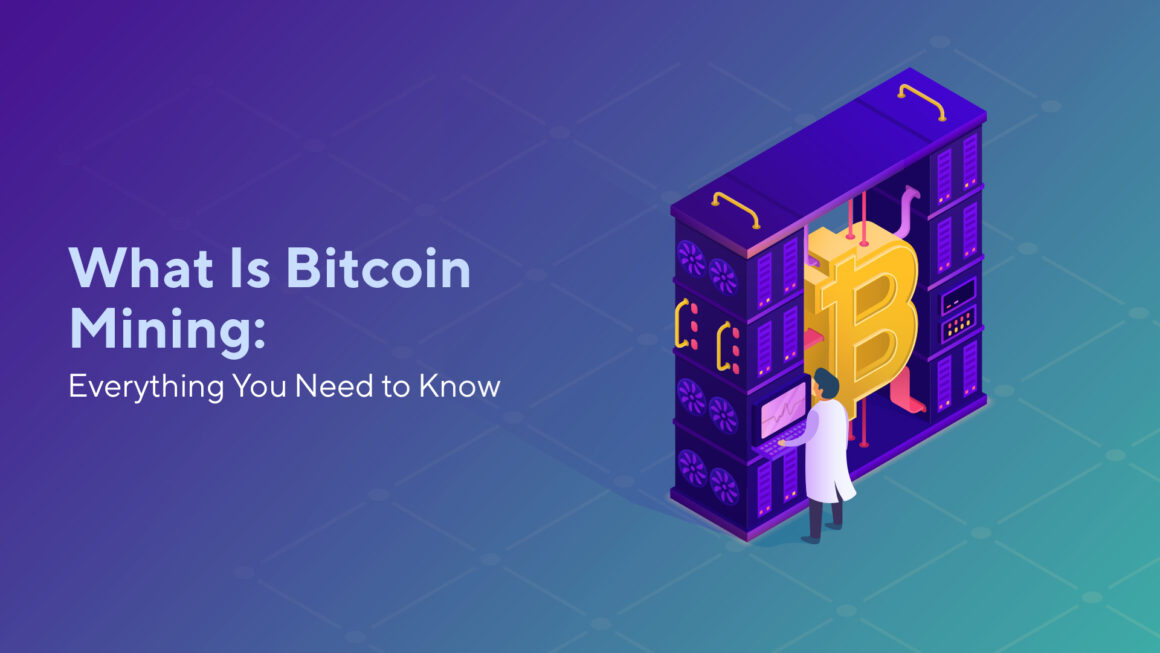Bitcoin is a digital currency generated by so-called Bitcoin mining. What is mining for Bitcoin? Well, first things first. The cryptocurrency was first described by Satoshi Nakamoto in the 2008 Bitcoin whitepaper. The project was launched a year later.
The special thing about this digital currency is that its coins are limited to a total of 21 million. However, these coins have yet to be generated. Unlike central banks, this doesn’t happen by printing coins, but by mining them. The process of crypto mining is often compared to gold prospecting. In this article, we describe what is bitcoin mining & how it works. Let’s get started!
What Is Mining for Bitcoin: How Does It Work?
What is mining for bitcoin? In order to understand the Bitcoin mining process, it’s necessary to consider underlying Bitcoin software. Bitcoin works as a decentralized network. The network consists of many computers around the world that have installed the Bitcoin software.
This software in turn contains the entire Bitcoin blockchain. This is important so that the network cannot be manipulated. If a computer is hacked, it’s automatically excluded from the network. This prevents double transactions. Therefore, users cannot repeat a transaction.
The blockchain is a kind of account book. The account book contains every Bitcoin transaction that has already been carried out, including detailed information about both sender’s and receiver’s wallet addresses. The blockchain is freely available. Technically, it consists of a series of encrypted blocks.
What Is Bitcoin Cloud Mining: Where to Mine Bitcoin?
Actually, there are three main ways to mine bitcoins. Today, you can mine bitcoins at home with appropriate hardware and software, in a mining pool, or with the help of cloud mining. Let’s consider all the ways in detail!
Bitcoin Mining at Home
Anyone who wants to mine bitcoins at home needs the right software & hardware. The simplest solution is to use a standalone miner such as Bitmain’s AntMiners. At the moment, it’s no longer efficient to mine coins on your PC via GPU. The interest in Bitcoin mining has become so great that developers create various chips specially for mining.
One example of this is the ASIC chip. It was developed for mining and cannot perform any other tasks. With ASICs, you can mine up to 100 times more efficiently than with your own GPU. At the same time, these chips use seven times less electricity.
Bitcoin Cloud Mining
What is bitcoin cloud mining? If you’re about to save on the cost of mining hardware and don’t want to install special Bitcoin software, you can rent hash power from cloud mining providers.
Genesis Mining considered the largest cloud mining provider on the market. There are also other worthwhile providers such as Hashflare, Omnia Mining, Crypto Gold or BitClub Network. Cloud mining providers even build mining farms in order to be able to rent hash power. The hash power can then be rented through contracts via a website of a respective provider.
What is bitcoin cloud mining at Genesis Mining? On the platform, it’s possible to conclude contracts for Bitcoin, Dash, Ether, Litecoin, Monero, and ZCash. The contracts have a fixed term and are available for a one-time fee. This fee is based on the amount of hash power that is to be acquired.
Bitcoin Mining in a Mining Pool
It’s quite clear that it’s important to generate the highest possible hashrate with as little electricity as possible. The right mining software is also crucial. The last way to mine BTC is to join a mining pool. How was mentioned before, if you want to mine independently, it’s enough to download and install Bitcoin software. However, what is a bitcoin mining pool?
Mining pools are associations of miners who in turn pool their computing power in order to find blocks faster. Examples of mining pools are AntPool, F2Pool, or Minergate. The advantage of mining pools is that a reward is shared among the participants.
What Is Mining for Bitcoin: BTC Mining in Detail
What is bitcoin mining? Let’s consider this question in more detail. Blocks consist of transactions that have already been carried out and hashes. The blockchain is created by Bitcoin mining. During mining, a PC that mines bitcoins uses a so-called SHA256 algorithm. This algorithm in turn is used to create hashes. Hashes are longer hexadecimal numbers that need to be calculated. Specifically, a hash looks like this:
93ef6f358fbb998c63302496863052290d4c63735c7fe5bdafc821de96a53a9.
It’s the solution to the already described arithmetic tasks that have to be solved during mining. Furthermore, these tasks must be calculated without changing the transactions made. To do this, miners change a different data set different from a hash itself, which carries transactions in encoded form. This record is called a nonce.
A nonce is processed together with a hash. Some nonce don’t match some hashes. Basically, a miner receives a reward when he/she has found the right nonce for the right hash. Only then transactions can be grouped into blocks. It usually takes several attempts to find a suitable pair. A pairing also depends on mining difficulty.
In addition, the more blocks have been created, the longer the blockchain becomes. So, what is mining for bitcoin? In a nutshell, miners compute complex arithmetic tasks to calculate hashes, which summarize transactions in blocks of the blockchain. As a result, the blockchain grows and all transactions are still recorded on it.
What other interesting facts about BTC mining do you know? Just share your knowledge in the comments!

Leave a Reply